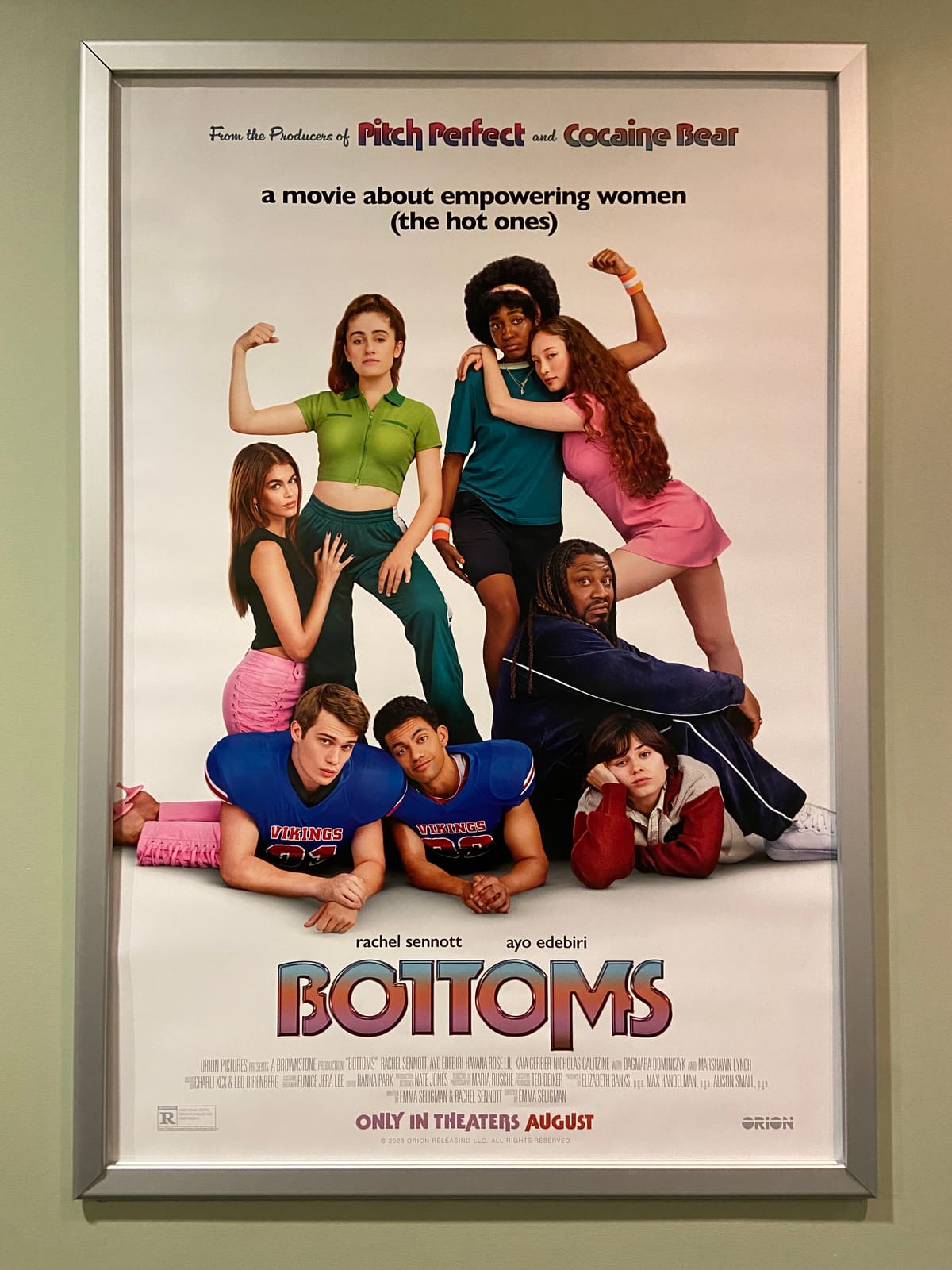Bottoms Up (Reviews Down?)
Managing Arts and Living Editor Sarah Weiner ’24 and Assistant Arts and Living Editor Sophie Durbin ’25 offer their opposing takes on the crass humor and familiar tropes of queer teen release “Bottoms.”

Arts & Living editors Sophie and Sarah watched “Bottoms,” a new movie from Rachel Sennott and Emma Seligman, at Amherst Cinema this past week. Having left the movie theater with different reactions to the film, they took to The Student to hash it out.
Sophie:
“Bottoms” enters the saturated field of high school comedies purporting to offer something new: the perspective of “untalented queers.” Untalented, I suppose, to differentiate itself from the overachieving queers of 2019’s “Booksmart.” Yet, “Bottoms” fails to offer a fresh take and instead relies upon archetypes like the dumb jock, the frivolous cheerleader, and the social misfit, without cleverly subverting them. Despite its exciting cast and emphasis on representation, the movie is a confused mishmash of derivative tropes.
Before watching “Bottoms,” I was excited to note its similarity to “Booksmart,” the film that upended the previously male canon of teen buddy comedies. “Bottoms” copies the “Booksmart” model of two unpopular queer girls trying to get laid before graduating high school, but misses its charm and sincerity. In place of Amy and Molly’s witty back-and-forths in “Booksmart,” “Bottoms” offers school shooter and rape jokes. “Girls can be offensive too!” the movie seems to say.
The characters in “Bottoms” lack depth, even the protagonists. They are unlikeable and reduced to tired stereotypes. PJ and Josie (played by Rachel Sennott and Ayo Edebiri, respectively) have none of Amy and Molly’s sisterhood — they seem to have little in common apart from their shared horniness. Their fight at the end of the film (another nod to “Booksmart” that falls flat) lacks stakes because they never seemed to like each other much in the first place.
The supporting characters in “Bottoms” are even more one-dimensional. Mean girls Brittany (Kaia Gerber) and Isabel (Havana Rose Liu) are relentlessly mocked for their eating disorders and stupidity. They never get the chance to show that they are more than vapid cheerleaders. In contrast, “Booksmart” redeems mean girl Triple A (Molly Gordon) with a wry yet heartfelt exploration of her vulnerability.
For a movie that boasts its diversity and representation, “Bottoms” is remarkably regressive. Much like their male counterparts in “Superbad” and “American Pie,” PJ and Josie continuously objectify and belittle their love interests throughout the course of the movie, viewing them as pursuits rather than people. PJ and Josie suffer from a lack of self-awareness reminiscent of their misogynistic film predecessors, resulting in their degrading treatment of Brittany and Isabel. Their friendship is a side note, something even “Superbad” got right.
Despite its numerous shortcomings, “Bottoms” was an easy watch due to its short length and rapid-fire dialogue, and I won’t lie that some parts made me laugh, especially scenes with effeminate football star Jeff (Nicholas Galitzine). However, its reluctance to leave behind age-old high school tropes and its strange embrace of crass humor left me disappointed and eager to rewatch “Booksmart.”
Sarah:
“Girls can be offensive too!” was the refreshing take I needed. While sometimes “Bottoms” does take this offense too far — by making light of eating disorders, sexual assault, and school shootings — watching high school lesbians mess up, lie, and genuinely live the rough parts of their existences offers a new perspective in comparison to the wholesome gays of recent teenage media like “Sex Education” and “Heartstopper.”
The side-by-side of PJ and Josie’s romantic arcs gives viewers one satisfying high school love story, and another that reminds us that sometimes things don’t work out. More than this though, Josie’s sweet relationship with Isabel serves as a healthy contrast to PJ’s objectifying obsession with Brittany, urging viewers to recognize PJ’s problematic pursuit of Brittany as a sexual object. Movies with male protagonists, or at the least those that have only one romantic arc, might be more successful in allowing this kind of objectification to go unnoticed. But when PJ looks Brittany up and down, or strategically positions herself on Brittany’s bed during their first hang out, it immediately strikes a different chord than Josie’s innocent diner homework session and near kiss.
“Bottoms” takes the task of “high school humor” almost too seriously, but the obscenity of the hyper-stereotyped football players is one of its cleverest jokes. The football players project an image of extreme masculinity through their constant donning of uniforms, use of phallic imagery, and violent vocal domination over their peers and competitors. On the other hand, their actions express their weakness: Jeff suffers from a deathly pineapple allergy and being lightly tapped by PJ’s car ends with him on crutches. Though the joke in this juxtaposition is unoriginal, its freshness ironically comes from being reused over and over. It works on two levels: Jeff’s comedic timing, and the fact that the only thing he and his football bros have to offer to the film is this one same joke.
The movie’s absurdity and vulgar humor screams that Sennott and Seligman have something just as extreme to say about lesbian romance, male high school football players, and female friendships. But perhaps like “Barbie,” this subtext is buried under so many layers of surface-level humor that it becomes a muddled mess of discourse I would trust only an expert in gender and sexuality studies to take on. I look forward to a theoretical analysis of “Bottoms” much more than any sequel.
I don’t think this is a movie that preaches female empowerment well — it ends with a group of girls murdering an entire high school boys football team with their bare hands, both a distasteful and unrealistic goal for young women — but that’s exactly what makes it so great. I can openly hate or love these characters with no judgment. I absolutely do not want to be like them, and therefore leave the movie feeling more confident about myself and prouder of my healthy female relationships than I did when I entered. It is empowering because it shows a world in which the queer girl is not the victim, but the mess-up. She is seen, and hated, not for who she is, but for how she acts, finally.





Comments ()